Mascaron (architecture)
In architecture, a mascaron ornament is a face, usually human, sometimes frightening or chimeric whose alleged function was originally to frighten away evil spirits so that they would not enter the building.[1] The concept was subsequently adapted to become a purely decorative element. The most recent architectural styles to extensively employ mascarons were Beaux Arts and Art Nouveau.[2][3] In addition to architecture, mascarons are used in the other applied arts.
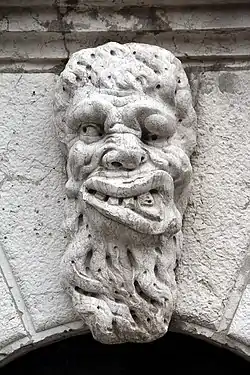
Mascaron adorning the front door of the campanile of the Church of Santa Maria Formosa in Venice.
Gallery
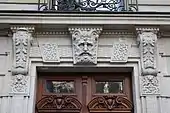 Mascaron above a door from Paris
Mascaron above a door from Paris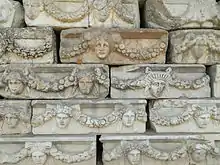
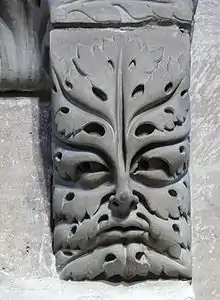
 The Three gorgons on the Secession Building from Vienna (Austria)
The Three gorgons on the Secession Building from Vienna (Austria) Chandelier with mascarons, circa 1710-1715, in the Metropolitan Museum of Art (NYC)
Chandelier with mascarons, circa 1710-1715, in the Metropolitan Museum of Art (NYC) Mascaron on a chair, circa 1875-1876, in the Metropolitan Museum of Art
Mascaron on a chair, circa 1875-1876, in the Metropolitan Museum of Art Mascaron on the frame of a dressing table mirror, circa 1700, in the Metropolitan Museum of Art
Mascaron on the frame of a dressing table mirror, circa 1700, in the Metropolitan Museum of Art Sculpted mascaron on the Palais Rohan (Strasbourg, France)
Sculpted mascaron on the Palais Rohan (Strasbourg, France).jpg.webp) Mascaron above an oculi window upside an Art Nouveau door in Strasbourg
Mascaron above an oculi window upside an Art Nouveau door in Strasbourg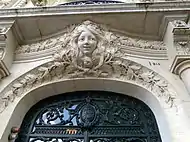 Art Nouveau mascaron from Paris
Art Nouveau mascaron from Paris Mascaron on a corbel in Paris
Mascaron on a corbel in Paris_(7575658724).jpg.webp)
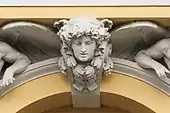 Mascaron of the Central Bank of Russia, from Moscow
Mascaron of the Central Bank of Russia, from Moscow Mascaron on the Hungarian State Opera House, in Budapest
Mascaron on the Hungarian State Opera House, in Budapest Mascaron of Hôtel du Commandant Militaire (Dijon, France)
Mascaron of Hôtel du Commandant Militaire (Dijon, France) Combination between a mascaron and cartouche, on the Staroměstská tržnice from Prague (Czech Republic)
Combination between a mascaron and cartouche, on the Staroměstská tržnice from Prague (Czech Republic)
 Mascaron with a swag, on the Berlin Cathedral (Germany)
Mascaron with a swag, on the Berlin Cathedral (Germany)

 Mascaron on the Castle of Enghien from the Parc d’Enghien from Belgium
Mascaron on the Castle of Enghien from the Parc d’Enghien from Belgium
See also
References
- "mascaron". Oxford Reference. oxfordreference.com. Retrieved 6 September 2016.
- "BUCHAREST 1870S MASCARON". casedeepoca.com. Retrieved 6 September 2016.
- "Art Nouveau in faces: fantasy world of "New art"". essenziale-hd.com. May 29, 2013. Retrieved 6 September 2016.
- Mascarons de Bordeaux (fr.wikipedia)
This article is issued from Wikipedia. The text is licensed under Creative Commons - Attribution - Sharealike. Additional terms may apply for the media files.
